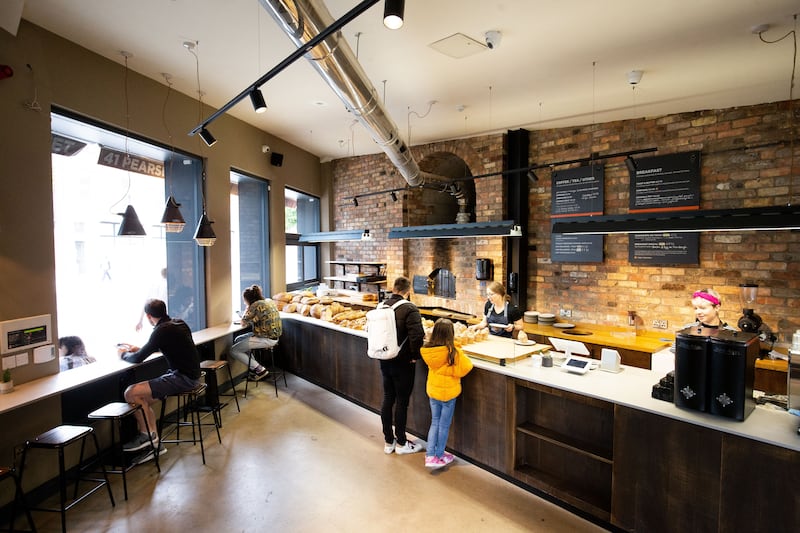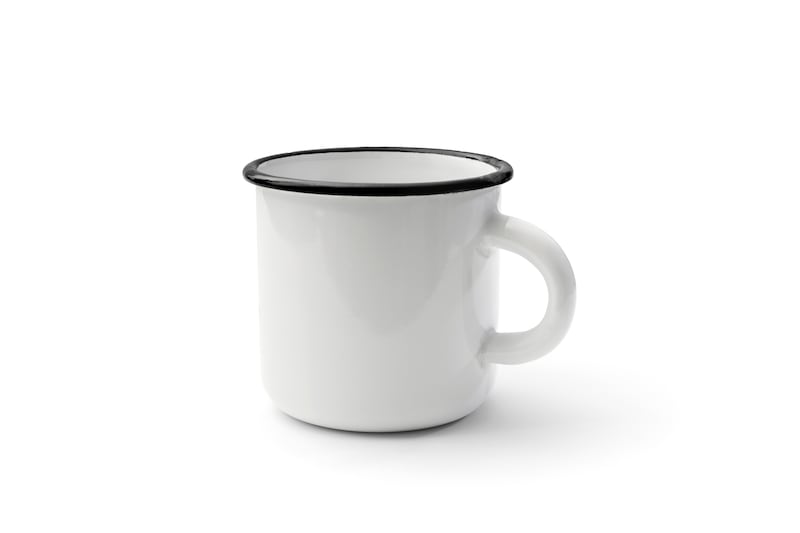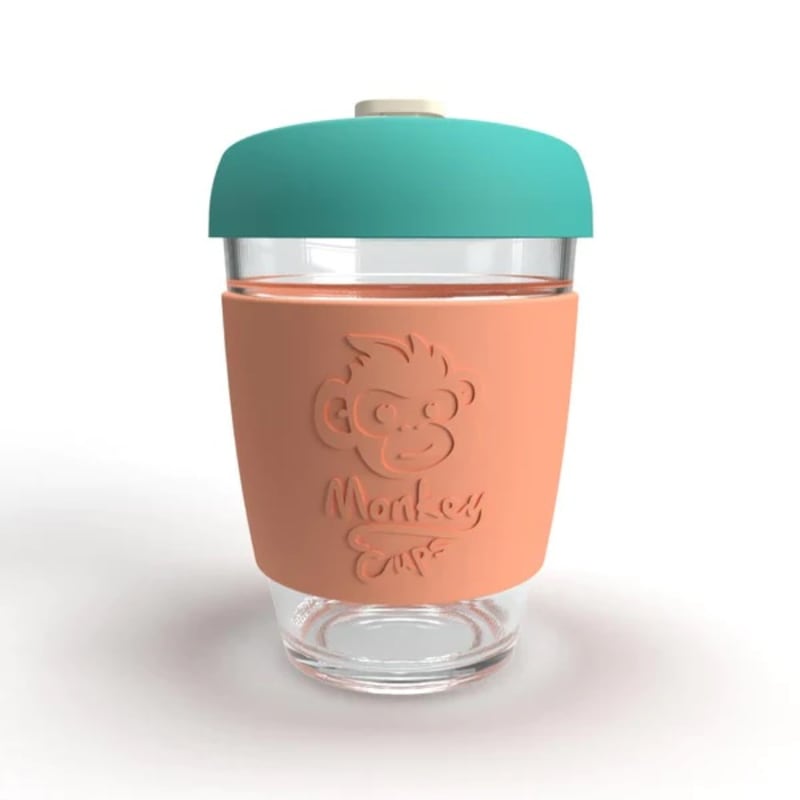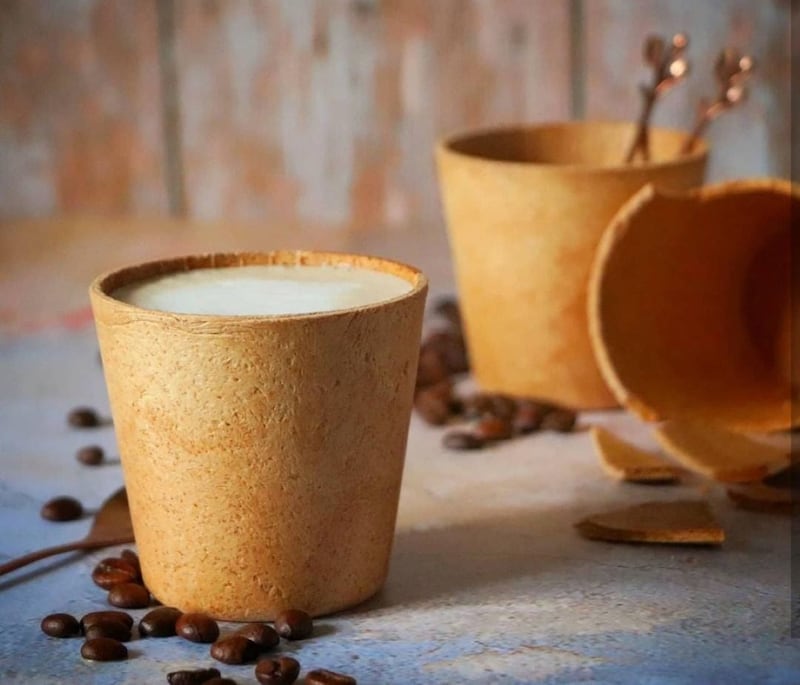There are four of them in my cupboard. My favourite one looks like corrugated cardboard. They are my reusable cup collection. So far so good. If only I didn’t keep forgetting to bring one with me when I leave the house. I’m not alone in my keep (it-in-the-cupboard) cup habit. More than two thirds of us own a reusable cup, but fewer than one in three is actually using it at a coffee counter regularly. So every day, around half a million caffeine fixes are served in disposable cups in Ireland.
They spend an average of 13 minutes in our hands before we toss them away. We are hooked on the convenience of a single use cup, comforting ourselves that it’s compostable, if we even pause to think about it. An estimated four million disposable cups hit bins, footpaths, waterways and motorway verges every week in Ireland.
This will become a more expensive habit later this year when the Government puts an environmental levy of 20c on disposable cups. Dubbed a “latte levy” (because who doesn’t love a bit of snappy alliteration?) the levy isn’t on the liquid, but on the single use cup. Eliminating disposable coffee cups alone won’t save us from catastrophic ecosystem collapse.

But the disposable cup is a ubiquitous part of the Make-Use-Toss culture driving the climate and biodiversity crises. Economist Madhavi Venkatesan explains it brilliantly in her podcast Sustainable Solutions: “We are in a cradle to grave economy,” she says, explaining the alternative concept of a circular economy. “We design for the dump, focused on the production and the monetisation of production and consumption. As long as disposal is cheap we just throw it away and produce more.”
READ MORE
Make-use-and-toss needs to come to an end. And there are smart people devising smarter conveniences that might not burn the place down around our ears. The ending of the disposable cup habit is something of a first step. If we start with the coffee cups so many of us use, could a reuse culture spread into other areas of life?
But first back to 1907 when the American invention of the disposable cup, or “health kup”, is credited to a fastidious Boston lawyer. Lawrence Luellen was upset by the public drinking water systems where a communal tin cup, or tin dipper, was attached to the fountain with a chain, to be shared by anyone who was thirsty.
Luellen’s waxed paper cup was charged at a penny a go when it was first rolled out. He renamed it a dixie cup after dixie dolls, a popular toy at the time. Their big break came with the 1918 flu epidemic. Suddenly disposable meant clean, and dixie cups became a public health measure. Polystyrene replaced paper in the 1950s and then fell out of favour. The lid arrived in the 1990s driven by cappuccinos, lattes and other fancy varieties of coffee that needed domed space for their fluffy heads.
‘Society is lazy and that’s the reality’
The takeout coffee became a status symbol; a busy successful life needed coffee to go. Lingering over coffee in a porcelain cup served in a cafe or diner became the exceptional way to consume a hot beverage. We went much more Boston than Berlin when it came to our coffee culture, and a coffee boom ensued. Cafes and coffee trucks could serve thousands of customers without the need for seating or the staff costs of washing cups.
And who would worry about a few paper cups? Weren’t they made from paper, a renewable resource? It seemed like a win-win.
The global population in 1907 when a Boston lawyer dreamt up a sanitary drinking cup was 1.7 billion people. A tiny fraction of that global population had access to and the means to afford his disposable cups. A little over a century later Covid would prompt a surge in single use cups, disposable cutlery and take-home containers, prompting us to shelve our reusable cup collection. Now the global population is 8 billion people and the environmental impact is mind-boggling.
For a while it looked like compostable packaging would provide problem-free convenience. But it was not to be. Dropping in greener alternatives without dialling down consumption is a beguiling idea. The more environmentally friendly option absolves us of guilt and problems of over-consumption are never challenged. But the planet only has so many resources. Fast fashion gives us organic T-shirts. Disposable cups go compostable. “Keep calm and carry on consuming,” is a comforting but delusional message.
Although we think of coffee cups as paper cups, they all have a plastic liner to enable them to hold liquid. In compostable cups, this liner is typically a bioplastic made from plants. Two of the main sources for commercial bioplastics are American corn and Thai sugar cane. Replacing conventional plastic packaging (made from fossil fuels) with bioplastics comes at an insane price.
A study in 2020 found that replacing all global plastic packaging with bioplastics would require more than half of all the global corn production, 12 times the current global production of castor beans and more than 60 million hectares of land with all the environmental costs of heavily-sprayed and fertilised monoculture production. The processed bioplastic is shipped by diesel burning cargo ships to Europe where most of the cup manufacturing happens.
Each cup contains around 33g of wood pulp grown in monoculture forests. The global timber cost of disposable paper cups is estimated to be 32 million trees a year. Then there’s the logging, transport costs of getting the timber to the paper mills, the many chemicals used in the paper process. Finally, most compostable cups are never composted. And if they’re not composted their bioplastics don’t break down adequately.
Disposable cups can be recycled, but the materials they create for reuse are of such low value that this recycling rarely if ever happens. To misquote the old fridge magnet, it’s a “moment on the lips a lifetime on the dump” cycle. In some ways, the compostable cup has proven about as useful as a chocolate teapot.
Ironically given their origins as a public health measure, the other undesirable feature of disposable cups is their potential health hazards. The plastic film that still lines many disposable cups is fragile and can degrade when exposed to hot water, leaching fluoride, chloride, sulphate and nitrate into your brew along with microplastic particles, 25,000 micron sized microplastics into a single cup of hot water in one study.
Ireland has a proud history of winning wars on single use waste. We were the first country to introduce a plastic bag tax in 2002 and it worked a charm. We went from using an average of 328 bags per person every year to just 14 within 12 years. Reusable “bags for life” became part of our shopping routines, left in car boots, folded into handbags. The Irish solution became a model for using environmental levies to prompt much needed behavioural change.
But shopping bags don’t need washing (barring spills), and that’s where the sticking (and sticky) point seems to be with reusable cups. Kevin Murphy is the 26-year-old founder of 2GoCup, and he’s come up with a solution to the problem of grubby reusable cups. We’re sitting in Bread41 on Dublin’s Pearse Street, where disposable cups are history. If you want a takeaway coffee from Bread41 you need to bring your own cup or buy a 2GoCup for €1.
“We know that 70 per cent of people own a reusable keep cup,” Murphy explains, “but only 30 per cent actually use it. Society is lazy and that’s the reality.” The company that he founded is not in the business of changing behaviour. (It’s too expensive and difficult, Murphy explains). They want to keep the frictionless convenience of a takeout coffee with a reuse option instead of a disposable one.
We are sipping our coffees from his grey ridged plastic cup with a blue silicone lid. I don’t have to wash it. I can hand it to the person behind the counter and receive my money back or another coffee in a clean cup. There’s no charge after I’ve paid my €1. On the day I inevitably forget to bring the reusable cup I can buy another one for €1 and return them to any participating cafe.
The system was designed to be economical for customers and to save businesses money. Even with the washing costs, cafes can save the costs of buying disposable cups. Murphy estimates it could save an average cafe €6,000 per year.
The polypropylene 2GoCups are made in China but production is moving to Wicklow in the coming months. Is this not just putting more plastic into the world? It is, but the cup can be used 1,000 times, Murphy says, which is more than three years of daily coffees. “After that it can go in your green bin.”
Stainless steel would be ideal, but more expensive. Two stainless steel reuse systems in the US, Vessel and Usefull, use an app and a credit card. Users upload the code on their stainless steel cup or bowl with a silicon lid and use a credit card to lodge a $15 deposit. They get a reminder to return their rented container within five days and if they do so, the use is free. If the container isn’t returned the deposit is forfeited.
The system is perfect for university campuses and small communities where food and coffee outlets can all take the returns and keep them in circulation. Murphy doesn’t think Irish consumers are there yet, but the low cost plastic version might get us closer.
‘We have people who keep a week’s worth, return them and basically get a free lunch’
Murphy came up with the idea on a college internship, when a person in the company where he was working “spilt coffee all over herself” from a disposable cup. He set up CoCup in partnership with DCU and Dublin City Council (DCC), worked with Zero Waste in Scotland and launched 2GoCup in April 2018 piloting the idea with DCU, Trinity College and DCC’s civic offices.
Then Covid hit. The pandemic drove reusable cups back into cupboards. Ironically it was during this dramatic fall off that 2GoCup found themselves working with a lot of hospital canteens. The system is now in 175 sites around the country in canteens like Intel and Boston Scientific and in five local authority areas, where environmental awareness officers have teamed up with local cafes to offer them free reusable cups. Tramore Eco Group all took the prototype cup early on in the evolution of 2GoCup and Murphy is impressed they still use them three years later.
The next stage will be a 2GoBowl where takeaway soups and salads can be given out in a returnable bowl to be washed by the cafe. The Circular Economy legislation which is bringing in the latte levy allows for the Government to start charging a levy on single use takeaway containers too. Cafes and restaurants will save money by having reusable containers, and the sooner they start stocking them the more money they will save, Murphy argues. “It’s like washing up the dishes. The longer you leave it the harder it gets.”
Reusable cups of varying sizes can be tricky for baristas, sometimes either too large or too small for a particular drink, or difficult to fit under coffee spouts and steamers. A standard cup makes everything simpler, and the more cafes who use them the more ubiquitous reuse gets. Cloud Picker Coffee, also on Pearse Street, are going to go with 2GoCups next so you will be able to leave Bread41 with a reusable cup and return it to Cloud Picker down the road. Brother Hubbard launched the scheme at their four Dublin outlets last month by giving away free coffees.
It’s not just city centre cafes who are getting ahead of the levy. Belinda Gildea signed up with the scheme more than two months ago and took her first shipment of 600 cups last month at Bay, the cafe she runs with her sister Maria near Brittas Bay in Co Wicklow.
She’s found that roughly 50 per cent of people offered the €1 cup take it up, “and they’re coming back with them which is great”. She likes the simplicity of the idea and the fact that it’s not an expensive purchase. “We can all remember buying cups that cost €35 or €40.″ They started a takeaway hatch during Covid and built up a large takeaway business. A lot of the success of the take-up comes from her willingness to talk to customers. “I’m turning into Greta Thunberg,” she jokes, “Not really. I’m not guilt tripping people.” She’s been talking about the million cups a week that are thrown away. I tell her it’s more like four million. That’s the new number she’ll be quoting from now on.
She ordered a box or two of disposable cups with the last coffee order just to be sure they won’t run short. But she is looking forward to eliminating the costs from her balance sheet and serving coffee in reuse cups or the porcelain cups that people sit down to use. “If disposable cups are completely gone then it’s a saving for everyone.”
In Bantry in West Cork, Russell Hardwick is operations manager of Organico. They shut down their sit-down cafe during Covid. Instead of disposable cups they moved straight to reuse. “And anything that would have been in porcelain went into 2GoCups.” In the year since they reopened in June of last year he has figures showing they have avoided nearly 6,000 cups going to waste by going with the reusable option. “We deliberately opened with reusable rather than disposable.”
All of their regular customers use the cup or multiple cups. “We have people who keep a week’s worth, return them and basically get a free lunch.” Hardwick is inspired by cafes like the Californian one where everything they sell is in glass mason jars which are bought with a deposit returnable when they are returned. We are some way off that yet. But things change slowly until they change quickly.
Greater environmental awareness, a summer of punishing heat, floods and fires in our news feeds and plenty of research showing people are concerned about plastic pollution and excess consumption are all at play as latte levy lands. If cafe owners work to educate their customers and adopt a scheme that could save them money, there can be wins for everyone. A new kind of takeaway coffee might kick-start more than just our mornings.
The best bring-it-yourself cups

1. The camping mug. It’s a small throwback to the shared tin mug of early 20th century US drinking fountains but the enamel coated stainless steel mug is probably the most practical and economical reuse cup. It doesn’t allow the take-and-walk option as it is lidless. But it’s easily wiped clean, plastic free, light and costs from as little as €2 from greatoutdoors.ie. Also it’s got a handle so the heat problem is allayed. Combined with a silicon lid, an enamel camping cup would be the business.
2. Recycled waste materials. Rice husks, coffee grounds, coffee chaff and plastic are all among the materials that are being refashioned into cups that can be reused hundreds of times before they have to be recycled. My rice husk cup from huskihome.com has proven very leakproof and able to keep coffee hot for longer. Another rice husk option is huskup.com.

3. Glass cups for the aficionado. Mailo Power dreamt up a better coffee cup at her kitchen table and called it a Monkey Cup based on the “100th Monkey Monkey Phenomenon of Social Change”, “the idea that once a certain number of a group start using a new habit it will be taken up instinctively by all,” according to her website. Her gorgeous glass barista cups with silicon lids and sleeves are made in Waterford and are available from €25 at monkeycups.ie.

4. Coffee in an edible cup makes the disposal problem go away in a few bites. Irish company Better Me makes edible wafer coffee cups. Beanhive on Dublin’s Dawson Street was trialling them earlier this year and is also a coffee shop with its own branded reusable mugs and tankards for sale. Better Me edible cups are available from €9.99 for a pack of 10 at better-me.ie.



















